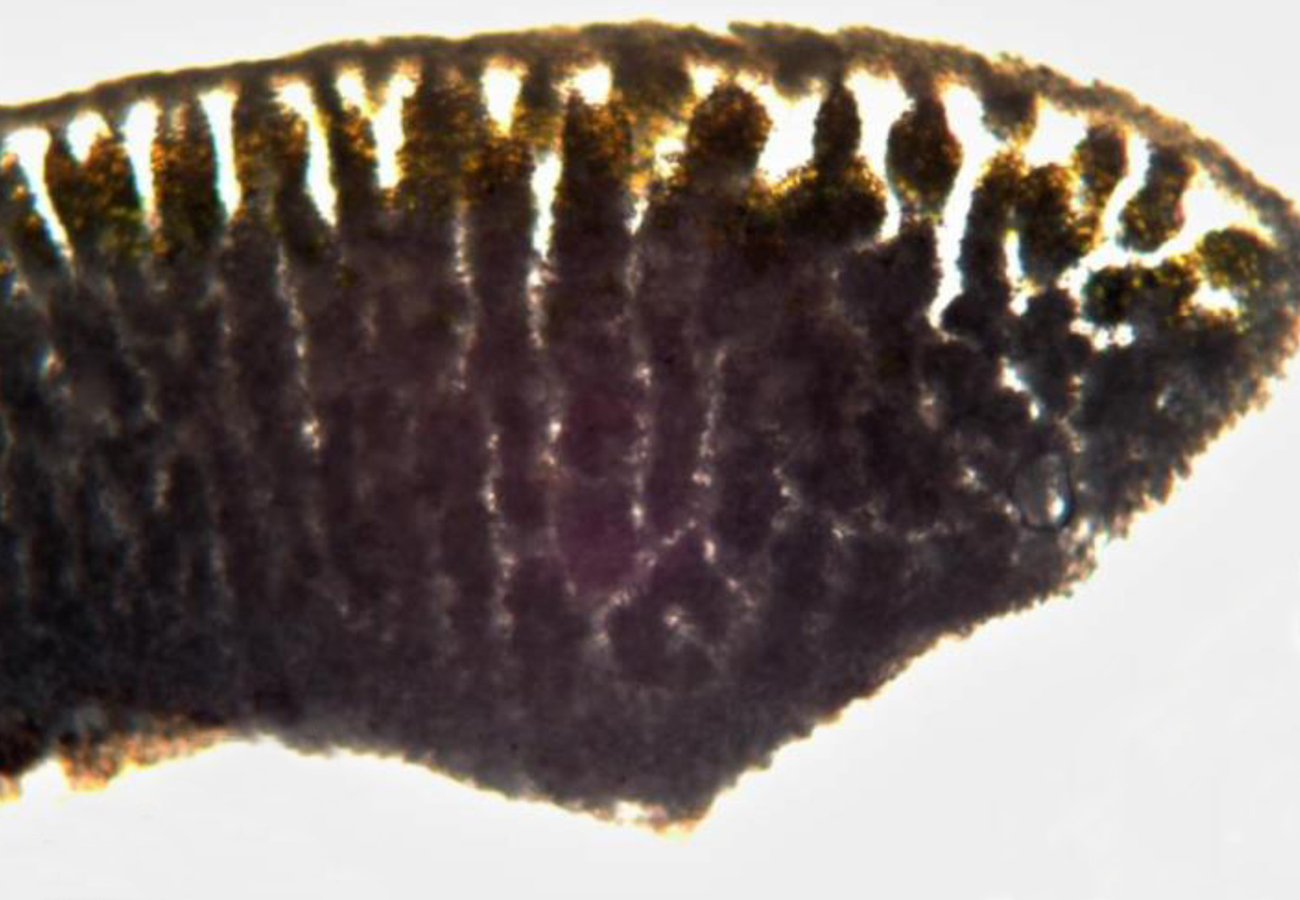Abstract
A new species in Megasporaceae, Aspiciliella pakistanica is described and illustrated from Pakistan. A comparative morpho–anatomical study and ITS–based molecular analysis confirmed its position within the recently resurrected genus Aspiciliella. The taxon is characterized by whitish–grey thalli having large and thick areoles without pale lines on the surface, and a discontinuous algal layer arranged in groups of vertical rows. Its positioning in a separate branch in the phylogenetic tree also makes it distinct from the other known species of the genus.
References
<p>Crous, P.W., Gams, W., Stalpers, J.A., Robert, V. & Stegehuis, G. (2004) MycoBank: an online initiative to launch mycology into the 21st century. Studies in Mycology 50: 19–22. <br>Gardes, M. & Bruns, T.D. (1993) ITS primers with enhanced specificity for basidiomycetes––application to the identification of mycorrhizae and rusts. Molecular ecology 2: 113–8. https://doi.org/10.1111/j.1365-294X.1993.tb00005.x<br>Haji Moniri, M., Gromakova, A.B., Lőkös, L. & Kondratyuk, S.Y. (2017) New members of the Megasporaceae (Pertusariales, lichen–forming Ascomycota): Megaspora iranica spec. nova and Oxneriaria gen. nova. Acta Botanica Hungarica 59: 343–370. https://doi.org/10.1556/034.59.2017.3-4.5<br>Hall, T.A. (1999) BioEdit: A User–Friendly Biological Sequence Alignment Editor and Analysis Program for Windows 95/98/NT. Nucleic Acids Symposium 41: 95–98. <br>Khan, M., Khalid, A.N. & Lumbsch, H.T. (2018) A new species of Lecidea (Lecanorales, Ascomycota) from Pakistan. MycoKeys 38: 25–34. https://doi.org/10.3897/mycokeys.38.26960<br>Kumar, P., Skouloudis, A.N., Bell, M., Viana, M., Carotta, M.C., Biskos, G. and Morawska, L. (2016) Real–time sensors for indoor air monitoring and challenges ahead in deploying them to urban buildings. Science of the Total Environment 560: 150–159. https://doi.org/10.1016/j.scitotenv.2016.04.032<br>Nordin, A., Savić, S. & Tibell, L. (2010) Phylogeny and taxonomy of Aspicilia and Megasporaceae. Mycologia 102: 1339–1349. https://doi.org/10.3852/09-266<br>Nylander, W. (1866) Circa novum in studio lichenum criterium chemicum. Flora (Regensburg) 49: 198–201. <br>Obermayer, W. (2002) Management of a Lichen Herbarium. Protocols in Lichenology. Springer Berlin Heidelberg, Berlin, Heidelberg, pp. 507–523. https://doi.org/10.1007/978-3-642-56359-1_29<br>Orange, A., James, P. & White, F.J. (2001) Microchemical Methods for the Identification of Lichens. First Edit. British Lichen Society, London, 101 pp. <br>Owe–Larsson, B., Nordin, A. & Tibell, L. (2008) Aspicilia. In: Nash, T.H., Gries, C. & Bungartz, F. (Eds.) Lichen Flora of the Greater Sonoran Desert Region. Lichens Unlimited, Tempe, Tempe, Arizona, pp. 61–108. <br>Paukov, A., Davydov, E.A., Nordin, A., Roux, C., Şenkardeşler, A., Sohrabi, M., Vondrák, J., Frolov, I.V, Teptina, A.Y. & Shiryaeva, A.S. (2019) Three new species, new combinations and a key to known species of Lobothallia ( Megasporaceae ). The Lichenologist 51: 301–322. https://doi.org/10.1017/S0024282919000264<br>Robert, V., Vu, D., Amor, A.B.H., Van de Wiele, N., Brouwer, C., Jabas, B., Szoke, S., Dridi, A., Triki, M., Daoud, S. B, Chouchen, O., Vaas, L., De Cock, A., Stalpers, J.A., Stalpers, D., Verkley, G.J.M., Groenewald, M., dos Santos, F.B., Stegehuis, G., Li, W., Wu, L., Zhang, R., Ma, J., Zhou, M., Gorjón, S.P., Eurwilaichitr, L., Ingsriswang, S., Hansen, K., Schoch, C., Robbertse, B., Irinyi, L., Meyer, W., Cardinali, G., Hawksworth, D.L., Taylor, J.W. & Crous, P.W. (2013) MycoBank gearing up for new horizons. IMA Fungus 4: 371–379. https://doi.org/10.5598/imafungus.2013.04.02.16<br>Sambrook, J. & Russell, D.W. (2006) Purification of nucleic acids by extraction with phenol: chloroform. Cold Spring Harbor Protocols, 2006(1), pp.pdb–prot4455. https://doi.org/10.1101/pdb.prot4455<br>Sohrabi, M., Rico, S.D.L.V.J., Halici, M.G., Shrestha, G. & Stenroos, S. (2013a) Teuvoa, a new lichen genus in Megasporaceae (Ascomycota: Pertusariales), including Teuvoa junipericola sp. nov. The Lichenologist 45: 347–360. https://doi.org/10.1017/S0024282913000108 <br>Sohrabi, M., Stenroos, S., Myllys, L., Søchting, U., Ahti, T. & Hyvönen, J. (2013b) Phylogeny and taxonomy of the “manna lichens.” Mycological Progress. https://doi.org/10.1007/s11557-012-0830-1<br>Thiers, B. (2019) Index Herbariorum: A global directory of public herbaria and associated staff. Continuously updated. [http://sweetgum.nybg.org/science/ih/]<br>White, T.J. & Garrott, R.A. (1990) PCR protocols: a guide to methods and applications. Academic Press Inc, San Diego, pp.315–322.<br>Zakeri, Z., Divakar, P.K. & Otte, V. (2017) Taxonomy and phylogeny of Aspiciliella, a resurrected genus of Megasporaceae, including the new species A. portosantana. Herzogia 30: 166–176. https://doi.org/10.13158/heia.30.1.2017.166<br>Zakeri, Z., Otte, V., Sipman, H., Malíček, J., Cubas, P., Rico, V.J., Lenzová, V., Svoboda, D. & Divakar, P.K. (2019a) Discovering cryptic species in the Aspiciliella intermutans complex (Megasporaceae, Ascomycota) – First results using gene concatenation and coalescent–based species tree approaches. PLOS ONE 14: e0216675. https://doi.org/10.1371/journal.pone.0216675<br>Zakeri, Z., Sipman, H., Paukov, A. & Otte, V. (2019b) Neotypification of Aspiciliella cupreoglauca and lectotypification and synonymization of Aspicilia reticulata ( Megasporaceae, Ascomycota). The Lichenologist 51: 97–99. https://doi.org/10.1017/S0024282918000476</p>


